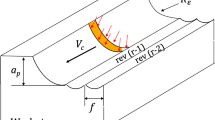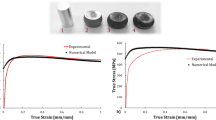Abstract
Residual stress is the most critical criteria of surface integrity affecting the fatigue life of manufactured components. Thermal, mechanical, and metallurgical effects generated during a machining process can cause this failure. In order to study this phenomenon, several simulation methods have been proposed in the literature, each with specific capabilities and accuracies. However, for a fundamental understanding, a new 3D numerical model is developed using a mixed approach that combines experimental data with numerical FEM model. This approach consists of replacing tool and chip formation with thermo-mechanical loadings equivalent to the tool action. The thermo-mechanical loadings move around the external surface of the workpiece and along the longitudinal direction in order to take into account the interactions between revolutions. It has been noted that the steady state was reached within three revolutions.
Based on this new approach, the present paper aims to investigate the model efficiency to predict residual stress with a reduced computational time. It is found that this mixed approach provides consistent results compared to experimental data obtained by X-ray diffraction.
Similar content being viewed by others
References
Jawahir IS, Brinksmeier E, M'Saoubi R, Aspinwall D, Meyer D, Umbrello D, Jayal A (2011) Surface integrity in material removal processes: recent advances. CIRP Ann Manuf Technol 60:603–626
Liu CR, Yang X (2001) The scatter of surface residual stresses produced by face turning and grinding. Mach Sci Technol 5:1–21
M. Kamaya and M. Kawakubo 2014 Influence of mean stress on fatigue strength of stainless steel, The Japan Society of Mechanical Engineers, vol. 80, no. 811,
Ren X, Zhan Q, Yang H, Dai F, Cui C, Sun G, Ruan L (2013) The effects of residual stress on fatigue behavior and crack propagation from laser shock processing-worked hole. Mater Des 44:149–154
Rech J, Hamdi H, Valette S (2008) Workpiece surface integrity. In: Machining: fundamentals and recents advances. Springer-Velarg, London, pp 60–96
Umbrello D, Outeiro J, M’Saoubi R, Jayal A, Jawahir I (2010) A numerical model incorporating the microstructure alteration for predicting residual stresses in hard machining of AISI 52100 steel. CIRP Ann Manuf Technol 59(1):113–116
Lazoglu I, Ulutan D, Alaca B, Engin S, Kaftanoglu B (2008) An enhanced analytical model for residual stress prediction in machining. CIRP Ann Manuf Technol 57:81–84
Miguélez M, Sanchez A, Cantero J, Loya J (2009) An efficient implementation of boundary conditions in an ale model for orthogonal cutting. J Theor Appl Mech 47:599–616
Nasr M, Ng E, Elbestawi M (2007) Modelling the effects of tool-edge radius on residual stresses when orthogonal cutting AISI 316L. Int J Mech Sci 47:23–41
S. Chatti (2009) Choix d'un algorithme explicit ou implicit pour la simulation du retour élastique, 19ème Congrès Français de Mécanique
Sasahara H, Obikawa T, Shirakashi T (2004) Prediction model of surface residual stress within a machined surface by combining two orthogonal models. Int J Mach Tools Manuf 44:815–822
Attanasio A, Ceretti E, Giardini C (2009) 3D FE modelling of superficial residual stresses in turning operations. Machining Science, Technology 13:317–337
Hamdi H, Zahouani H, Bergheau J (2004) Residual stresses computation in a grinding process. J Mater Process Technol 147:277–285
Valiorgue F, Rech J, Hamdi H, Gilles P, Bergheau J (2012) 3D modeling of residual stresses induced in finish turning of an AISI304L stainless steel. Int J Mach Tools Manuf 53:77–90
Mondelin A, Valiorgue F, Rech J, Feulvarch E (2012) Hybrid model for the prediction of residual stresses induced by 15-5PH steel turning. Int J Mech Sci 58:69–85
Valiorgue F and Rech J (2016) Numerical modeling of residual stresses in turning of a 27MnCr5 steel, in 3rd CIRP Conference on Surface Integrity
Guillemot N, Winter M, Souto-Lebel A, Lartigue C, Billardon R (2011) 3D heat transfer analysis for a hybrid approach to predict residual stresses after ball-end milling. Procedia Engineering 19:125–131
Zemzemi F, Rech J, Salem W, Dogui A, Kapsa P (2007) Development of a friction model for the tool-chip-workpiece interfaces during dry machining of AISI4142 steel with TiN coated carbide tools. International Journal of Machine Tools,Manufacture 2:361–367
Barge M, Hamdi H, Rech J, Bergheau JM (2005) Numerical modeling of orthogonal cutting: influence of numerical parameters. J Mater Process Technol 164-165:1148–1153
Salvatore F, Saad S, Hamdi H (2013) Modeling and simulation of tool wear during the cutting process. Procedia CIRP 8:305–310
Johnson GR, Cook WH (1985) Fracture characteristics of three metals subjected to various strains, strain rates, temperatures and pressures. Eng Fract Mech 21:31–48
Mabrouki T, Rigal JF (2006) A contribution to a qualitative understanding of the thermo-mechanical effects during chip formation in hard turning. International Journal of Materials Processing Technology 176:214–221
Tabor D, Bowden F (1951) Friction and lubrification of solids. University Press, Oxford
Shi G, Deng X, Shet C (2002) A finite element study of the effect of friction in orthogonal metal cutting. Elsevier Science 38:863–883
Schmidt A, Roubik J (1949) Distribution of heat generated in drilling. Transaction of the ASME 71:245–252
Zemzemi F (2007) Caractéristation du modèle de frottement aux interfaces pièce-outil-copeau en usinage : application au cas de l’usinage des aciers et de l’inconel 718. LTDS-LGM, Lyon
Li X (1996) Study of the jet-flow rate of cooling in machining Part 1: theoretical analysis. J Mater Process Technol 62:149–152
Salvatore F, Halila F, Mabrouki T, Hamdi H (2012) Numerical and experimental study of residual stress induced by machining process. Int J Surface Science and Engineering 6(2012):136–147
Pantalé O, Bacaria J-L, Dalverny O, Rakotomala R, Caperaa S (2004) 2D and 3D numerical models of metal cutting with damage effects. Comp Meth Appl Mech Eng 193:4384–4399
Author information
Authors and Affiliations
Corresponding author
Rights and permissions
About this article
Cite this article
Rami, A., Kallel, A., Sghaier, S. et al. Residual stresses computation induced by turning of AISI 4140 steel using 3D simulation based on a mixed approach. Int J Adv Manuf Technol 91, 3833–3850 (2017). https://doi.org/10.1007/s00170-017-0047-1
Received:
Accepted:
Published:
Issue Date:
DOI: https://doi.org/10.1007/s00170-017-0047-1




